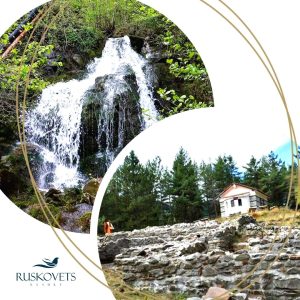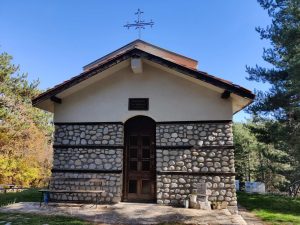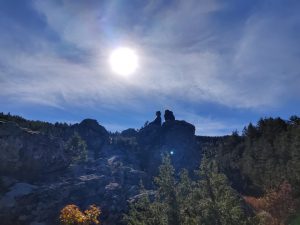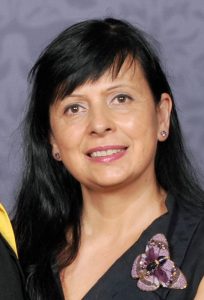The natural landmark is halfway between Bansko and Dobrinishte, at the foot of the Pirin mountain. There are several lines by which you can reach it. From Dobrinishte there is a Polish road suitable for cars or mountain bikes. From Bansko, the path through the forest from the DKP area to the Barevi swamps is picturesque. There is also a section of the asphalt road Bansko-Dobrinishte, stopping at the church “St. George”. The road is Polish, not good for any type of vehicle. It stops at the pine forest and from there it continues for a short time on foot.
The waterfall is 100m high. Banskalians call him “Skoko”. It is part of the natural fortification of a settlement with a centuries-old life and an important point on the ancient road from Belomorieto, through the Roman city of Nikopolis ad Nestum, along the Mesta river valley to Skaptopara /Blagoevgrad/ and Serdika.

Archaeological research of the popular “nameless city” began in early 2003. until 2017 by a team of the museum complex in Bansko, headed by the local archaeologist Vladimir Baryakov and student volunteers, as a continuation of a tradition established in 1986. by Prof. Alexander Fol. The directions for the searches come from Banskalians, who have revered the place since time immemorial as “troyalishche” /from traja-malcha/ – in the Banska dialect, a holy place where one is silent and pays respect to the god. The foundations of an early Christian basilica and necropolis, up to 1.20 m thick, were discovered. the fortress walls of the inner city /on an area of 6 decares/ and part of the settlement outside the walls /with an assumed area of 25-30 decares/.
The coins found are an important sign of life at that time. The population was probably a mixture of Thracians and Goths. The settlement functioned as a trade center and a strategic observation point for the valley.
The numismatic material found covers the period IV-VI century and contains coins from the time of the Roman emperors Constantius II, Theodosius II, Anastasius I. An exception is a silver grossh, a Rhodope imitation of a Venetian matapan from the 1430s. It is assumed that here there was continuous life until the 18th century. To date, a new church has been built on the foundations of the early Christian church with the patron saint St. Nicholas.
What to do in the St. Nicholas
The fortress in the area of St. Nikola is part of a well-developed trade and defense network of the Razlog hollow. Forest roads connect the Sitan Kale fortress in Bansko and the Saint Panteleimon monastery in Dobrinishte.
If you are a fan of archeology, you can take a detailed look at the construction of the remains of the fortress walls. You will most likely notice two periods in the construction style, separated by fire and new construction. The walls are basically stone, joined with mortar, and after the destruction, the mortar was replaced with clay. You can look around for the town planning line oriented east-west, climb to the highest point of the hill and enjoy the spaciousness of the valley.

В
In the recent past, the area was a paradise for beekeepers. The numerous bee farms formed a community and produced honey of exceptional color richness and aroma.
Today you can organize a picnic by the river and prepare for mountain hikes: to the DKP area in Bansko, to the Sitan Kale fortress in the Caves area above Bansko, to Mocharata above Dobrinishte and in the meantime pick berries, mushrooms and herbs.
A marked mountain bike trail passes through Sveti Nikola, which is marked on the digital map of the Pirin National Park. For more information on this matter, we recommend that you download the Pirin National Park mobile application, available on the Googleplay platform, to your phone.

The overall historical picture of the region is connected after a visit to the ethnographic museum “Radonova Kashta” in Bansko on “Aton” Street 3 /intersection of “Pirin” Street/. Here is exhibited material from the archaeological expeditions in the territory of Bansko. The museum operates with a lunch break from 9:00 a.m. to 5:30 p.m. excluding Sunday and Monday.
The Saint Nicholas area can be visited with a guided tour from the museum complex in Bansko.
The program is from Monday to Friday, starting at 10:00. Price: BGN 15. per person. Advance booking is required.

